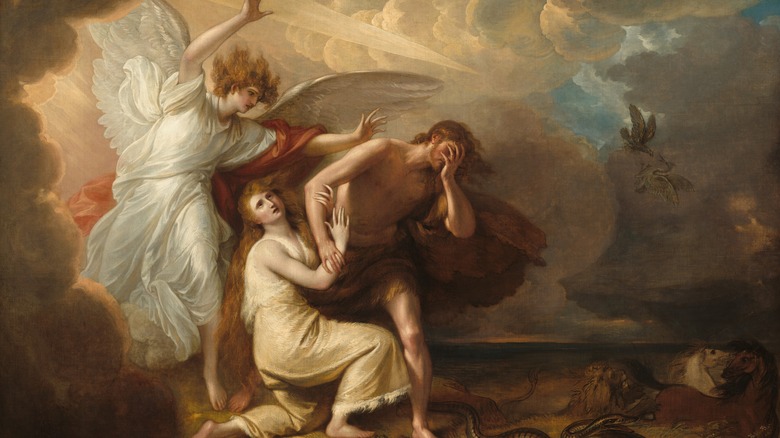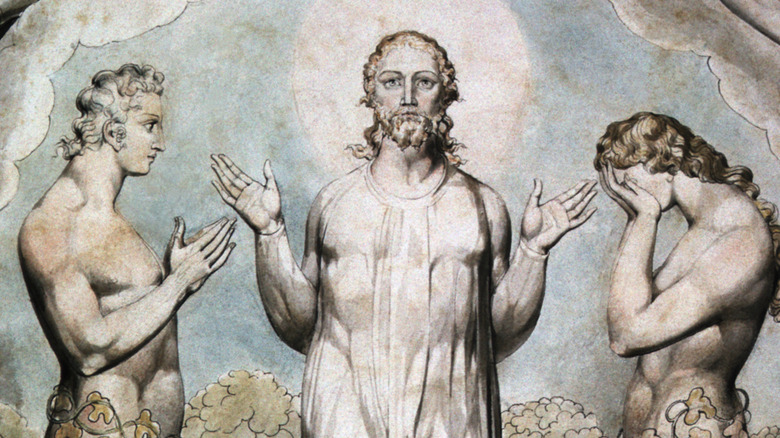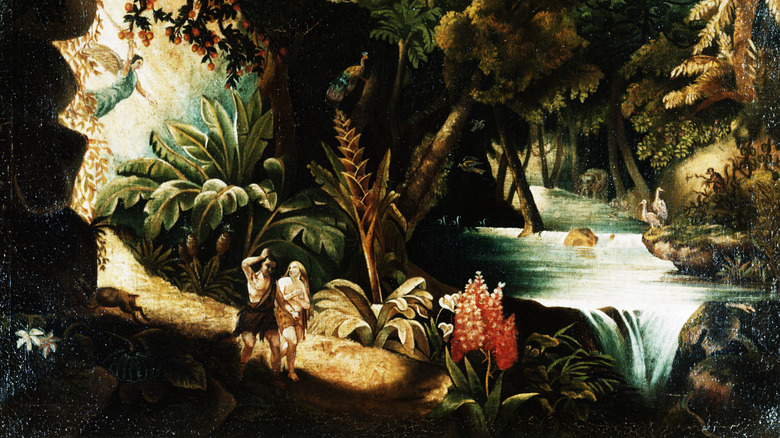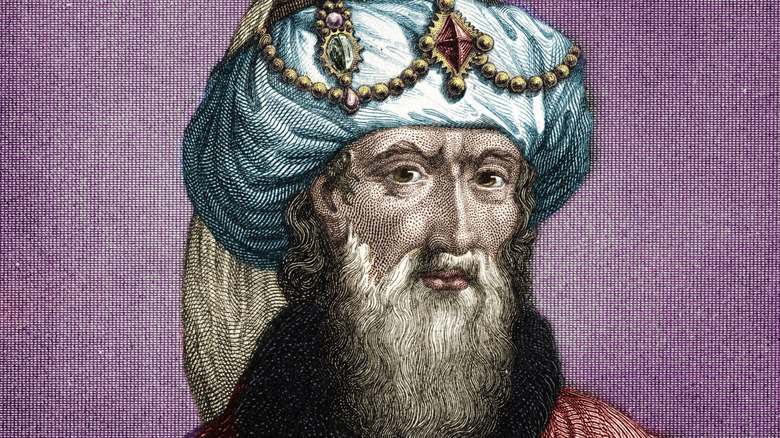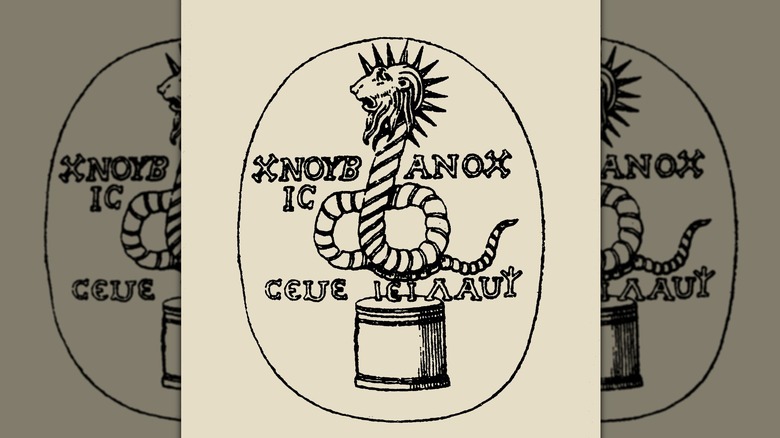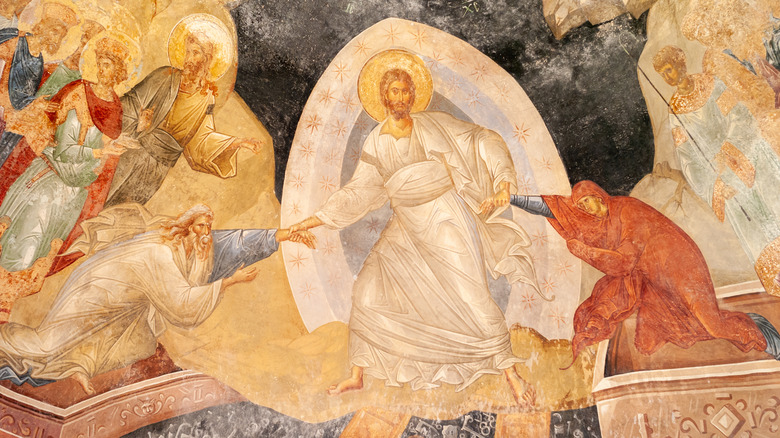The Hidden Truth About Adam And Eve's Forgotten Third Son
The story of Adam and Eve and their progeny is perhaps best known as a depiction of a fall from grace. First the parents are cast out from paradise, then the children introduce murder and kinslaying to humanity. Cain and Abel are among the most notorious names of the Bible, and they're the most prominently featured of any of Adam and Eve's children in Genesis.
But Adam and Eve were fruitful, and they reproduced many more than two children in their long lives. Per Bible Gateway, Genesis 5 mentions "other sons and daughters," though a number isn't given anywhere in the Good Book, (books outside the biblical canon do spotlight the daughters). The scripture does single out one of these other children, though: Seth, the son born to Adam and Eve after the murder of Abel. The name "Seth" has been translated as "granted" or "appointed," and Eve describes him in Genesis 4 as God's gift to her and Adam for the son they lost.
While he alone of Adam and Eve's later children is named, Seth isn't prominently featured in Genesis. His lifespan (912 years) and oldest son (Enosh) are mentioned in Genesis 5, and that's all that's said of him in that book. But Seth attracted considerable attention in the ancient world. Rabbinical literature, Roman histories, and observers of Gnosticism all took interest in him and expanded upon the biblical tradition. Here are some things you may have never known about the third son of Adam.
Seth was conceived to prove a point
In the Bible, there was no particular motivation behind Seth's conception. Adam and Eve simply copulated after Abel's death and counted their new child as a gift from God. But Midrashic literature, a genre of interpretive rabbinical texts, framed his birth as a fulfillment and reinforcement of the injunction to "be fruitful and multiply."
The story goes that Lamech, a descendant of Cain, took two wives. Genesis 4 described how Lamech killed two men and warned his wives that as Cain would be avenged seven times, he, Lamech, would be avenged seventy-seven. The Midrash identifies one of the slain as Cain himself, whom the blind Lamech killed in an accident. Because any children the women had by Lamech would be of the seventh generation from Cain, they refused to lie with him and bring forth any children who would be cursed.
At Lamech's request, Adam came to his wives and chastised them. "Who are you to preoccupy yourselves with the ways of the Lord? He does what He must do, and as for you, do your duty as wives!" he told them, very much reflecting a more ancient time and attitude. The wives snapped back that, since the death of Abel, Adam and Eve have not slept together nor had any more children. Unable to argue, Adam and Eve came together and had Seth.
He spoke with the archangels at the gates of Eden
While the Bible records nothing about Seth between his birth and that of his son, Jewish apocryphal texts featured him prominently. "The Life of Adam and Eve," also known as the "Apocalypse of Moses," tells how Adam fathered 30 sons and 30 daughters and asked that they all come to his bedside when he felt the approach of death. Adam told his children of the fall from grace he had experienced, and the afflictions of the body that God had visited upon him for breaking his covenant. He asked that Eve and Seth go to the gates of the Garden of Eden to beg of the angels oil from a tree that might ease his pain.
Along the way, an unspecified beast attacks Seth and refuses Eve's command to retreat, blaming her for bringing "the rule of beasts" to be by her sin. But when Seth orders the beast to leave them, the beast replies, "Behold, I stand off from the image of God," and returns to his lair. The threat gone, Seth and Eve continue on to the gates of paradise, where God sends the archangel Michael to meet them. Michael tells Seth that the oil he seeks will be given to all mankind, but only at the end of days and the moment of resurrection.
Michael adds a command — that Seth return to his father and witness the spectacle of death. This Seth does, along with all his brothers and sisters. But he alone witnesses Adam's collection for burial by the Lord in Eden.
Josephus might have mistaken Seth for Sesostris
Seth attracted the interest of Flavius Josephus, the Jewish scholar and historian. Josephus came from a priestly family in Jerusalem and once petitioned to release imprisoned priests, but he was swept up by the might and culture of the Roman Empire. Caught up in a failed revolt, he later surrendered to the Romans, correctly predicted that Vespasian would become emperor, and won freedom and patronage from the imperial house.
Josephus' "Antiquities of the Jews" expanded on the lives of several Genesis figures, Seth among them. "Antiquities" describes him as a "virtuous" man or "excellent character," one who passed on his high morals to his children and theirs. One of his line was Noah, who served the rejuvenation of humanity after the flood. This is in contrast to the line of Cain, whose life Josephus also expanded on (you won't find much in the Bible). His descendants became ever more wicked with each generation.
Josephus also credited the line of Seth with preserving human knowledge and invention on two pillars — one of brick and one of stone — against Adam's prophecy that the world would be destroyed. These pillars would allow mankind to rebuild after the destruction, and Josephus described them as still existing in the land of Siriad (i.e. Egypt). This was challenged by William Whiston, his English translator. Whiston believed that Josephus confused Seth with Sesostris, an Egyptian pharaoh who did leave pillars standing in Siriad. A believer in the truth of the Genesis flood story, Whiston considered it impossible for any of Seth's works to have survived the calamity.
His name was applied to a Gnostic sect
Since at least the third century, Seth's name has sometimes been applied to the earliest sect of Christian Gnostics. The term "Sethian" was applied to the group by Hippolytus of Rome, a bishop and avowed critic of Gnosticism. It's unlikely that the early Gnostics would have referred to themselves by Seth's name, and modern scholars sometimes object to the use of "Sethian" as a term to distinguish the classical Gnostics from later sects.
But Seth did loom large in early Gnostic beliefs, which held that Eve was raped in body by demonic beings after her creation. These demons, not Adam, were the father of Cain and Abel, but when they assaulted Eve, her spirit left her body. In contrast, her relations with Adam were consensual, loving, and tinged with the presence of both souls. Seth, therefore, was the first true son of Adam and Eve, and the first born with a trace of God-granted animating spirit. His descendants were counted a race apart (race in this context referring to religious and spiritual distinction) from those of Cain and Abel, with the demons who fathered them continually trying to tempt and suppress the line of Seth. The coming of Jesus was the trump card needed for Seth's people to have spiritual superiority over demonic temptation. The Gnostics, naturally, counted themselves among the children of Seth, set against the other races of humanity.
Seth was a savior figure in early Christian writing
Genesis 5 lists Seth as the first link in the chain connecting Adam to Noah. In fact, given the timeline of Genesis, Seth would have died just 14 years before Noah was born. Both the Bible and Midrashic literature claim that Noah and his family were the sole survivors of the great flood, which would make Seth a direct ancestor of all mankind once the Earth was repopulated. He is also counted, after Adam, as the father of the Israelites. He's placed near the head of the line of David and, in Christianity, of Jesus.
It was in the early Christian period that various writings began depicting Seth as a semidivine savior figure. Though not placed on the level of Jesus, he exhibits great power and goodness, sometimes employed through combat, sometimes through teaching. "The Coptic Gospel of the Egyptians" had him see through all the deceits of the devil. "The Apocalypse of Adam" had him receiving a savior prophecy from his father Adam. Other writings put him to war against the Roman Empire, providing escapist apocalyptic literature to suppressed Jews and Christians.
